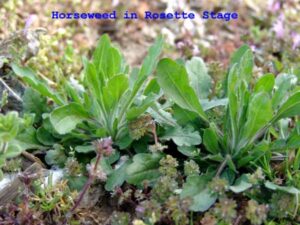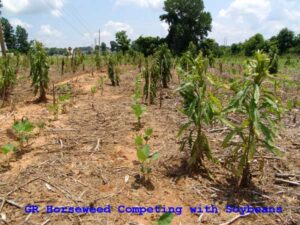LINKS
Horseweed Conyza canadensis (L.) Cronq.
Also Known As: marestail, fleabane, Erigeron canadensis L.
Classification and Description:
 Horseweed is a member of the Asteraceae or sunflower family. In a recent study conducted at Jackson and Knoxville it was found that horseweed can germinate and emerge in all months but December and January. Therefore, in Tennessee it can effectively have both a winter annual and summer annual growth habit. Horseweed has erect, simple stems, unbranching below but branching at the inflorescence, with straight, coarse, rather stiff hairs. This weed can grow to heights of 1-9 feet tall. Its leaves are alternate, blades simple, numerous and crowded on the stems. Horseweed typically flowers from June to September and reproduces by seeds which can number from 50,000 to 250,000 seeds per plant. These seeds are very small and easily spread by wind. Horseweed has small white or slightly pinkish ray flowers and yellow disc flowers. Insects are the major pollination unit. There are some allergenic properties of horseweed pollen to humans.
Horseweed is a member of the Asteraceae or sunflower family. In a recent study conducted at Jackson and Knoxville it was found that horseweed can germinate and emerge in all months but December and January. Therefore, in Tennessee it can effectively have both a winter annual and summer annual growth habit. Horseweed has erect, simple stems, unbranching below but branching at the inflorescence, with straight, coarse, rather stiff hairs. This weed can grow to heights of 1-9 feet tall. Its leaves are alternate, blades simple, numerous and crowded on the stems. Horseweed typically flowers from June to September and reproduces by seeds which can number from 50,000 to 250,000 seeds per plant. These seeds are very small and easily spread by wind. Horseweed has small white or slightly pinkish ray flowers and yellow disc flowers. Insects are the major pollination unit. There are some allergenic properties of horseweed pollen to humans.
Historical:
Horseweed is native to Tennessee and can be found throughout the state in agronomic crops, pastures, orchards, roadsides and waste areas. Horseweed was not a major problem in agronomic crops until early this decade. A biotype of horseweed that was resistant to glyphosate was first documented in Tennessee in Lauderdale County in 2000. Since 2000 horseweed has quickly spread to become a serious problem in row crops in all the counties of West Tennessee counties and in many counties in Middle Tennessee. Approximately 1 million acres of cotton and soybeans are infested. Most recently glyphosate-resistant (GR) horseweed has become a problem in corn production with the increased adoption of Roundup Ready corn.
Weed Status and Injury:
 Horseweed can be found in virtually every field often in large numbers in the spring. It is resistant or tolerant to many herbicides used for burndown in conservation tillage production systems. This has effectively decreased conservation tillage acres in Tennessee. In a recent survey it was found that conservation tillage production systems in cotton decreased from about 80% to 40% in 2004 with many citing GR horseweed as the reason. Moreover, it has proven to be a very competitive weed. In one study in 2004, horseweed that competed with cotton from crop emergence to the 5th node decreased seed cotton yield by 450 pounds/A.
Horseweed can be found in virtually every field often in large numbers in the spring. It is resistant or tolerant to many herbicides used for burndown in conservation tillage production systems. This has effectively decreased conservation tillage acres in Tennessee. In a recent survey it was found that conservation tillage production systems in cotton decreased from about 80% to 40% in 2004 with many citing GR horseweed as the reason. Moreover, it has proven to be a very competitive weed. In one study in 2004, horseweed that competed with cotton from crop emergence to the 5th node decreased seed cotton yield by 450 pounds/A.
Interesting Facts:
Horseweed is a favorite host for tarnished plant bugs which are a major pest of cotton. Horseweed contains volatile oils, tannic acid and gallic acid that may cause mucosal and skin irritation in livestock and humans. Horses are especially susceptible. In the Plains States, Native Americans used horseweed as an astringent and early settlers used it to treat diarrhea and dysentery. Another interesting point about horseweed is that it is one of the few native weeds that North America “has given” to Europe (Weeds of Nebraska and the Great Plains 1994).
Management Considerations:
Management of glyphosate-resistant horseweed has become one of the biggest challenges for growers throughout Tennessee. The glyphosate-resistant biotype of horseweed has now ended the era of glyphosate only weed control for cotton and soybean fields. Moreover, recent research conducted by the University of Tennessee has found that horseweed will germinate from March through November. Weed management programs must be constructed that utilize herbicides with different sites of action as well as herbicides that provide residual control and/or can be applied post emergence or post-directed. Please refer to page 7 in the Weed Control Manual for Tennessee Row Crops PB 1580 for management recommendations.
Literature Cited:
Gleason, H. A. and A. Cronquist. 1963. Manual of plants. 280-282.
Heap, I.M. 2005. International survey of herbicide-resistanct weeds.







